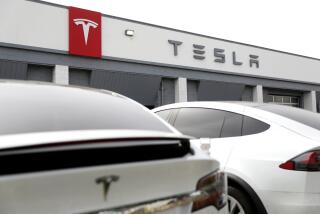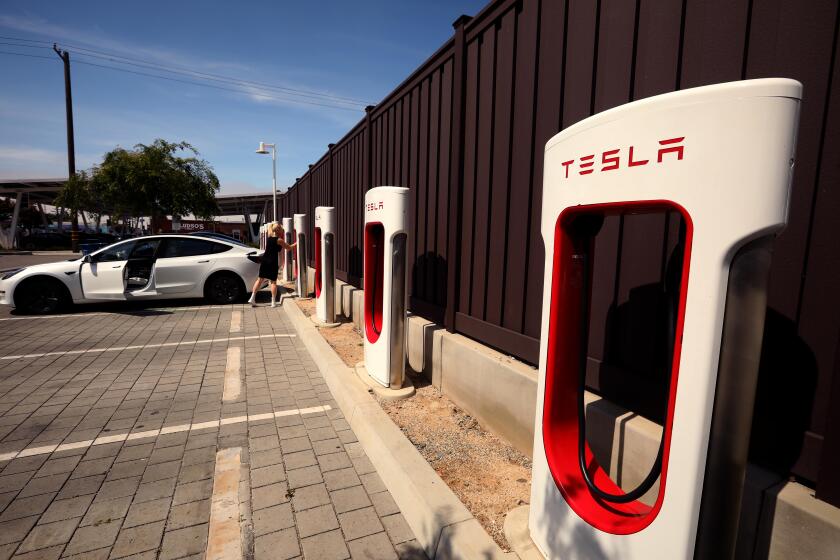Detroit Auto Show: Jaguar to court younger buyers with XE compact sedan
At some point, every luxury automaker stares down the same challenge — taking on the venerable BMW 3-series.
That time has come for Jaguar. It’s the next step in a rapid reinvention of the storied British brand, now enjoying a renaissance under corporate parent Tata Motors Ltd..
Jaguar will start selling the XE compact sedan in the U.S. next year. The move, announced Sunday ahead of the Detroit Auto Show, aims to attract new and younger buyers.
Jaguar has tried this before. Citing the same goals in 2001, under Ford ownership, the brand launched the woeful X-type sedan. Based on a European Ford model, the X-type never came close to its sales goals. U.S. sales ended in 2007 and the model died in 2009.
There’s a growing consensus that the results will be different this time. Jaguar Land Rover has produced a string of hits since 2012, when Tata, India’s largest automaker, greenlighted a $3-billion investment in new models and engines.
Tata paid Ford Motor Co. $2.3 billion for both the Jaguar and Land Rover brands in 2008, then merged them into a single company.
“Jaguar has transformed in the last two years,” said Karl Brauer, an analyst at car information company Kelley Blue Book. “The brands are being controlled by a capable parent company that will invest and make sure they know how to win.”
That investment has paid off with the sleek F-Type coupe and convertible models that reestablished the brand’s sports car credentials. It also produced the new Range Rover and Range Rover Sport, both about 700 pounds lighter than their predecessors thanks to the heavy use of aluminum. The diet made both vehicles more responsive and fuel efficient.
Jaguar’s reinvention extends to aesthetics, bringing back some of the brand’s sexy swagger, especially in the full-size XJ and mid-size XF sedans.
The automaker plans to continue its aggressive development, also announcing Sunday that the Jaguar brand will introduce its first sport utility vehicle, the Jaguar F-Pace, which also will begin selling next year. Additionally, the Land Rover Discovery Sport, another compact SUV, will reach dealers later this year.
The Jaguar crossover will be “the ultimate practical sports car — a car that builds on the brand’s founding ideals of ‘Grace, Pace and Space’ to become one of the most innovative Jaguar vehicles we’ve ever developed,” said Andy Goss, Jaguar Land Rover’s global sales director.
Both new vehicles target markets where German car company BMW has been a dominant player, selling both the X-3 crossover and the 3-Series line of sedans. BMW sold nearly 477,000 3-Series sedans globally last year, including about 100,000 in the U.S.
Worldwide, 3-Series sales alone are more than Jaguar Land Rover’s total sales of 462,678 vehicles last year.
Ed Kim, vice president of industry analysis for consulting firm AutoPacific Inc., said he doesn’t believe Jaguar has any aspiration of unseating the 3-Series, which he calls “the gold standard of this segment.” Bigger companies including Mercedes-Benz, Audi and Lexus have all tried and failed. But the Jaguar XE will try to steal some sales from BMW.
Jaguar has other new plans for models across its lineup. Taking a cue from Audi, Jaguar Land Rover this year will start rolling out diesel engine options for nearly every model it sells in North America.
The automaker will introduce two luxury diesel SUVs this fall: the Range Rover Td6 and Range Rover Sport Td6. Both use a turbocharged six-cylinder diesel power plant that pushes the big SUVs to 25 miles per gallon for combined city and highway driving, a 32% improvement over the gasoline-powered V-6 also available in the models.
The Td6 engine produces 254 horsepower and goes from zero to 60 mph in a little more than seven seconds.
But it is the two smaller vehicles, the XE and the F-Pace, that represent Jaguar’s greatest opportunities for growth. Both are in growing, high-volume industry categories.
The XE reaches U.S shores next year and will come with an engine choice of the powerful 3-liter V-6 used in the F-Type and a new Ingenium 2-liter turbocharged diesel engine. The V-6 will put out 340 horsepower and be mated to an eight-speed automatic transmission.
The XE will be the first vehicle to have the newly designed Jaguar Land Rover modular architecture. This aluminum-intensive unibody chassis is made of an aluminum alloy that is mostly recycled metal. The XE is expected to weigh less than competitors from BMW, Mercedes or Lexus.
“The XE does bring some interesting attributes that will help differentiate it from competitors,” said AutoPacific’s Kim. “The aluminum construction should give it some advantages in fuel efficiency and performance.”
Jaguar plans to launch the car in the U.S. only with all-wheel drive, a feature luxury sedan drivers prefer in the snowy winter climates of the Northeast and Midwest. Diesel and rear-wheel-drive versions will follow. Jaguar has not announced pricing, but it is expected to be competitive with the BMW 3-Series, which starts in the mid-$30,000s.
“The XE represents a chance to bring a lot of new people into the Jaguar family,” said Kim McCullough, vice president of marketing for Jaguar Land Rover North America.
McCullough expects 80% of the sedan’s buyers will be people who have never owned a Jaguar. Most will be in their 30s to late 40s and have a certain level of affluence, she said. “The biggest challenge for the brand is to bring in new and younger customers,” McCullough said.
The automaker believes it will capture sales from other European competitors and find buyers who own brands such as Acura and Cadillac, “but are looking for something more expressive in their garage,” she said.
Although Jaguar has not released any F-Pace details, analysts believe the automaker will use many components from the XE to build the compact crossover.
The crossover “is an obvious business play,” Kelley Blue Book’s Brauer said. “With the XE, they already have a platform and the engines. Once you have that it would be a waste not to produce the crossover.”
Small crossovers like the F-Pace are one of the fastest-growing segments of the U.S. auto market.
“The compact crossover category is on fire,” Bauer said. “You have to be in there if you are a premium brand.”
If the entry-level models succeed for Jaguar, it could convert younger buyers into loyal customers who will later purchase more expensive models.
“Jaguar is an established and old brand, but one that has aggressively kick-started its image,” Kim said. “The F-Type is a purist’s sports car and takes the company’s image from that of a gentleman’s brand to something youthful and edgy. The XE has the potential to continue in that direction.”
Twitter: @latimesjerry







